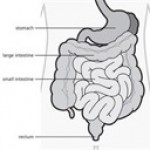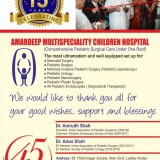Hirschsprung’s disease is a rare disorder of the bowel, most commonly the large bowel (colon), which can lead to severe constipation and intestinal obstruction. Hirschsprung’s disease affects one in every 5,000 babies.
Normally, the muscles in the bowel squeeze rhythmically to push faeces (stools) through to the rectum. In Hirschsprung’s disease, the nerves that control these muscles (ganglion cells) are missing from part of the bowel. This means that stools cannot be pushed through the bowel in the usual way.
The length of the affected part of bowel varies from child to child. Most commonly the rectum and/or sigmoid colon (the last parts of the large bowel) are affected. The entire colon is affected only very rarely.
What causes Hirschsprung’s disease?
Hirschsprung’s disease is a congenital (present at birth) disorder. While your baby was developing in the womb, the nerve cells did not develop through the full length of the bowel. We do not know what caused this to occur, but it was not due to anything that happened during pregnancy. A number of genes causing Hirschsprung’s disease have now been identified, although not all children have a specific genetic mutation.
What are the signs and symptoms of Hirschsprung’s disease?
The main symptom of Hirschsprung’s disease is constipation, which cannot be treated using laxatives or softeners. This occurs because faeces (stools) are pushed through the bowel until they reach the affected part. As this part of the bowel cannot squeeze rhythmically to push the faeces (stools) through the bowel, the faeces cannot move any further. As more food is digested and turned into faeces, the bowel becomes blocked causing discomfort and a swollen abdomen.
Often babies with Hirschsprung’s disease do not pass meconium – the dark faeces passed in the first day of life. Other symptoms include a swollen abdomen and green vomiting (bile).
How is Hirschsprung’s disease diagnosed?
Hirschsprung’s disease can be suggested on x-rays, either a plain x-ray or a contrast / barium enema. Some sections of the bowel look very bulged but the section after looks narrower than usual.
It is more reliably diagnosed by taking a small piece of tissue from the bowel to examine under a microscope. This is called a rectal biopsy. If the piece of tissue does not have any ganglion cells, this means Hirschsprung’s disease has been diagnosed.
How can Hirschsprung’s disease be treated?
How Hirschsprung’s disease is treated depends on the age at which your child is diagnosed and how well your child is generally. All children will require surgery at some stage.
Some children’s constipation can be helped on a short-term basis using enemas (bowel washouts), where a thin tube is inserted into your child’s bottom and filled with a warm saltwater solution. This softens the faeces and flushes it from your child’s bowel.
If a child is newborn or generally well, we may suggest treating the Hirschsprung’s Diseaselaparoscopically in one operation called a ‘laparoscopic assisted pull-through’ operation. This is where the affected part of the bowel and then connects the healthy section directly to the anus to allow faeces to be passed.
If a child is older or not very well, we may suggest a staged operation. First, we will create an artificial opening (stoma) for the bowel as a temporary measure. This will allow your child to pass faeces through the stoma, allowing their health to improve before the pull-through operation. In the event of the child already having a stoma prior to visiting this hospital, a laparoscopic pull through operation is still possible.
Are there any alternatives other than surgery ?
No. Eventually, all children will need surgery to treat the Hirschsprung’s disease.
What happens before the operation?
The child will need to come into hospital two – three days before the operation. This is so your child’s bowel can be empty of faeces(stools) and ready for the operation. He or she may have laxatives or a bowel washout, and will be allowed to drink clear fluids for 24 hours before the operation.
What does the operation involve?
The surgeon will identify the part of the bowel missing the ganglion cells using a series of biopsies and remove it. Once they have removed the affected portion of bowel, they will attach the end to the anus to create a working bowel, with enough nerve cells to control the muscles so that your child can pass faeces as usual.
If your child is having a staged repair, a stoma may need to be formed first so that they can get better before they have the pull-through operation. As with the pull-through operation, the surgeon will identify the affected portion of bowel using a series of biopsies and remove it. They will then bring the end to an artificial opening in your child’s abdomen called a stoma. This means faeces can be pushed through the bowel to the stoma, where they are collected in a bag to be disposed of later. Some weeks later, in another operation, the surgeon will remove the part of the bowel missing the ganglion cells as in the ‘pull-through’ operation.
The stoma will be closed when your child has had the pull through operation, either during the same procedure or a few weeks or months later.
Are there any risks?
Every anaesthetic carries a risk of complications, but this is very small. Your child’s anaesthetist is an experienced doctor who is trained to deal with any complications. All surgery carries a small risk of bleeding during or after the operation. There is a very small chance that the bowel could leak into the abdominal cavity. If this occurs, your child will need a stoma as this reduces the risk of developing a serious infection called peritonitis.
What happens afterwards?
The child will come back to the ward to recover. We will keep your child as comfortable as possible by giving regular pain relieving medications. For the first few days, the pain relief will usually be given through a ‘drip’ and then, when your child is more comfortable, in the form of medicines to be swallowed. For the first few days, your child will need a ‘drip’ of fluids until they feel like eating and drinking again. This will also allow the bowel to rest and start to heal. You will be able to go home once he or she is comfortable.
When you get home
After the pull-through operation, your child may have soreness around the anus when passing faeces normally. You can try using coconut oil to clean your child’s bottom, as this will also ease any discomfort. It will also help to use nappy cream after each nappy change. We will discuss this further with you before you go home. Whenever possible, leave your child’s bottom open to the air as this will help it heal too.
Are there any long-term effects of the operation?
Although the pull-through operation is very successful at treating Hirschsprung’s disease some children develop problems afterwards, some of which we are able to treat.
Constipation may be seen after the pullthrough operation, which may require treatment with medications. Toilet training in children who have had the pull-through operation may be delayed, mainly due to having to learn to coordinate the nerves and muscles in the rectum and anus. Children should follow a normal balanced diet after the pull-through operation.
Sometimes children with Hirschsprung’s disease can develop an infection called Hirschsprung’senterocolitis. If your child develops diarrhoea.If not responding to oral medications, the child may need to come into hospital for a short stay to receive treatment with fluids and antibiotics.
What is the outlook for children with Hirschsprung’s disease?
Overall, the outlook for children with Hirschsprung’s disease is good, with the majority growing up to live normal lives, working and raising a family.If you have a child with Hirschsprung’s disease, future children may be at increased risk of also having this condition.





